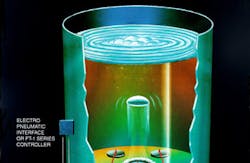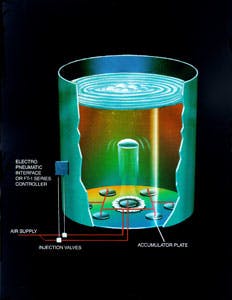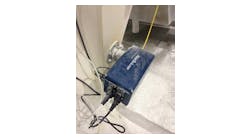Pulse-air mixing addresses viscosity, volume challenges
While use of pulse-mixing is appropriate when solids need to be kept suspended in liquid, its developers say it is probably not the way to go when solids need be dissolved in a liquid-filled tank. In these cases, the shear created by a mechanical mixer contributes mightily to solids blending.
But the almost-complete lack of shear with the pulse-mixing method can be, in many other type applications, one of its biggest benefits. "It’s a major selling point," says John Voorhies, director of sales and services, Pulsair Systems. "If you’re simply moving a liquid, and shear is of no benefit to you, then we have the advantage. Even with a 10-million-gallon capacity tank results can be delivered faster, and by closely managing compressed-air usage, less energy consumed."
Nitrogen is used as the agitating gas in most instances when air is not, i.e., in food, wine, chemical and petroleum industries where oxidation is a concern or the environment hazardous.
Originally developed and patented about thirty years ago by Bellevue, Wash.-based Pulsair Systems and its founder, Dick Parks, pulse-mixing already today sees significant use by lubricant blenders and for large-volume storage tanks. The pulse-air mixing process is sold as a highly engineered kit through national distributors for on-site installation by user or contractor personnel.
Given the proven efficacy of its solution and its innovative business and distribution model, the company believes other industries will find significant uses for the solution.
"With our NSF certification for potable water tanks we see growth in this area. Railroad tank cars and shipping containers have high integrity," says Voorhies, "but also some real mixing challenges. All of our equipment is outside the tank which eliminates a number of DOT regulatory requirements from concern. The system also works extremely well in accelerating the heating of liquid products in rail tank cars by controlling the pulses of air through the bottom drain outlet. It’s also of interest that through the elimination of all electrical and electronic components, the process can be used in explosion-proof environments."
Applications and specifications
For lubricant blenders, use of pulse-air mixing is a "natural" because mixing is accomplished independent of the liquid’s viscosity, Voorhies says. "The same holds true when two liquids of different viscosities are blended. The liquid with the higher specific gravity will of course tend to settle at the bottom of the tank. Because the mixing action is from bottom to top, that heavier liquid is swept up and brought to the top. Other types of agitation don’t deliver this."
As gas "squeezes" out between the accumulator plates and tank floor, gas gathers at each plate into a very large, single oval-shaped bubble. Bubbles from the plates then rise to the surface: 1) the vacuum created pulls the heavier bottom liquids upwards and 2) liquids above the bubbles are pushed up and out toward the tank side and then down the tank wall, returning to the bottom.
"Strategic placement of pulse points and accumulator plates on the tank floor means virtually 100 percent of the tank’s contents are moved," Voorhies says. "The extremely low surface area to volume ratio and short residence time of the air precludes any meaningful transfer between the bubbles and liquids and vice versa. This reduces the possibility of air entrainment into the liquid."
Process control regulates the amount of air, pressure and time, i.e., mixing speed, depending on tank size and volume, product viscosity and temperature requirements. Pulse rate can be related to "mixer speed." It is essentially the frequency of pulses or number of pulses per minute, set at the controller. The pulse rate varies based on the size of the tank, volume and viscosity of the liquids.
Compressed air or gas flow is a function of the system’s pulse rate, injection time and injection pressure. The injection time or pulse duration determines how long the injection valve is open during the pulse. Injection pressure is measured in pounds per square inch of the pulse when it goes into the tank. In a heavy slurry application or high viscous liquid a higher injection pressure is used.
Benefits of innovation
Because of its "bottom-up" mixing pattern, pulse-air mixing is said to be thorough, involving 100% of the tank’s liquid contents. Sequential mixing patterns provide uniformity and temperature distribution. The system mixes at any liquid level — no minimum liquid depth is required as with mechanical mixers. The system is able to adjust to a wide range of varying conditions in the same tank. No "I" beams, motor supports or tank bracing or internal tank baffles are required when retrofitted into existing tanks or basins.
Pulsair says its mixing method is 30 to 50 percent faster than mechanical mixers, and 75 to 90 percent faster than conventional air mixing, sparging or recirculation. Further, the larger the tank is, the greater the advantage. The mixing process is efficient and fast because it harnesses gravity to move the liquid in the tank. Pulsair says its mixing method uses 40-60 times less compressed air or gas than spargers and 25 to 75 percent less energy than mechanical mixing methods.
In closing, Voorhies emphasizes that pulse-air mixing operates without seals, gears, motors, shafts, impellers or baffles. "There’s no moving parts in the tank or vessel. The only thing that moves is the product. Zero in-tank maintenance reduces the need to take tanks off-line for maintenance."
Pulse-air mixing can keep solids, sludge and sediment suspended in liquids, maintaining uniform and homogenous product because bubble creation stirs up and scours the tank bottom. The vacuum created behind the rising bubbles lifts the heavier liquids and solids to the top of the tank. A storage tank can become a production blending tank; expensive and hazardous tank-bottom cleaning costs can be eliminated.




